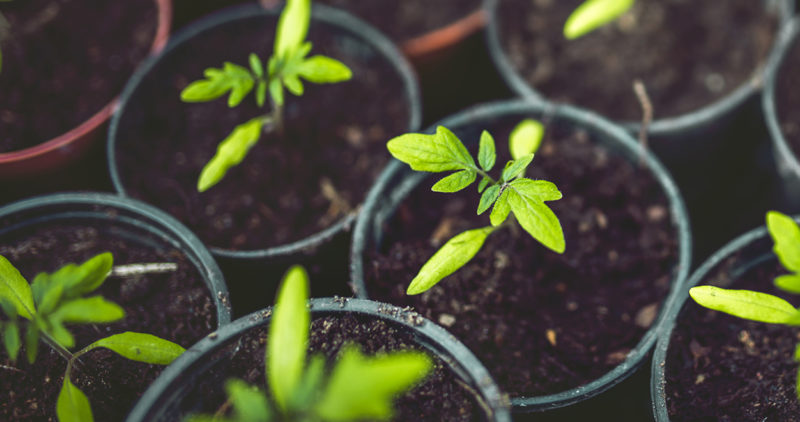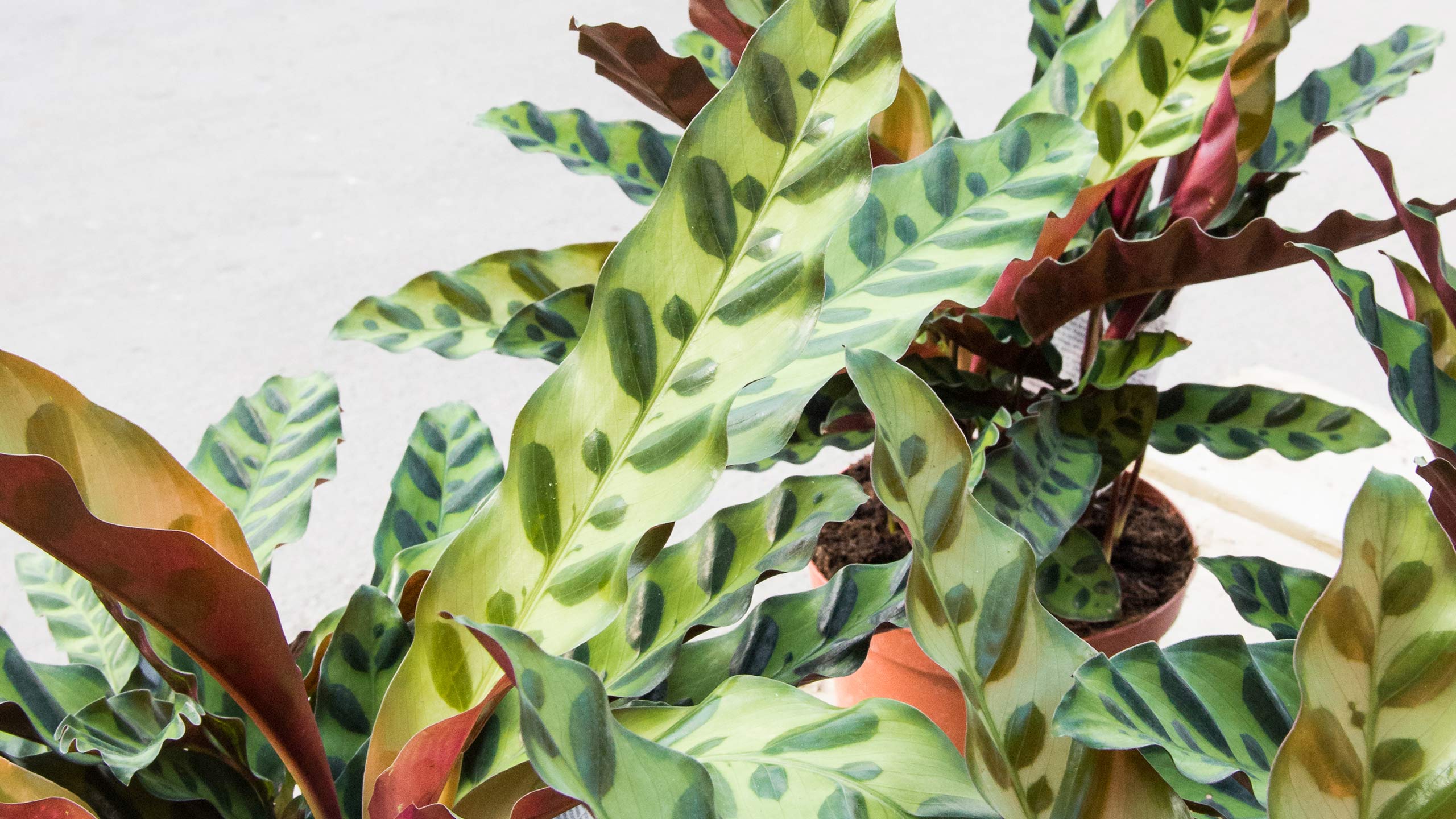
Houseplants come in so many different colors, styles, and textures – plant collectors know then how exciting it can be to bring a new plant into a collection. All plants are beautiful in their own way, but some have a unique appearance that sets them apart from the classic displays of leafy greenness. In the greenhouse, we have some truly striking houseplants whose boldly patterned foliage and vivid tropical coloring attract attention from both customers and our team. We’d love you to meet a few favorite stand-outs – each from the beautiful rainforests of Brazil: calathea, stromanthe, and prayer plant.

Calathea
Calathea is a genus of eye-catching plants native to warm tropical regions including the rainforests of Brazil. Several species of Calathea are popular as houseplants, and with common names like peacock plant and zebra plant, you get the idea that they don’t really blend into their surroundings. Right now, we have one known as rattlesnake plant, Calathea lancifolia – although in the greenhouse, we typically refer to them simply as calatheas. This calathea is an upright plant with oblong, lance-shaped leaves. The pattern on the foliage is amazing. Each leaf has a pale green background with distinct olive-green oval blotches that alternate between large and small along the midrib. The leaf edges are also framed in olive-green. Flip over a leaf, and you’ll find a wash of reddish-purple that only partially obscures the rattlesnake pattern. Calatheas are also known for their ability to raise and lower their foliage in response to changes in light – although not always as noticeably as the prayer plant, a fellow member of the Marantaceae plant family.
For the best display of color and pattern, find a spot in your home with fairly bright, but indirect light. Full, direct sun on the foliage will fade the patterning and possibly cause the leaves to burn. As rainforest natives, calatheas also appreciate a warmer location with a little humidity in the air too. Greenhouse team member Erica Tirendi says a bright kitchen is the perfect spot. If you start to notice crisp edges on the foliage, the air might be a little too dry – sitting your plant on a pebble tray with water will help. And they love our humid summer days, so when the nighttime temperatures begin staying above fifty degrees, consider moving your calathea to a shady spot outside. They also need consistently hydrated soil – water and drain thoroughly when the surface of the soil begins to dry just a bit.

Stromanthe
Another member of the Marantaceae family is Stromanthe sanguinea, which we commonly refer to as simply stromanthe. We have the cultivar ‘Triostar’ – an upright plant with long, lance-shaped leaves that arch downward. Topside, the foliage pattern is striking, with shades of three different colors – silvery-green, cream, and red – appearing in a random arrangement of broad and narrow stripes. No two leaves are the same. Like the calathea above, ‘Triostar’ also has a bright reddish-pink coloration on the underside of each leaf.
Care is similar to calathea’s care too. Stromanthe plants enjoy bright, indirect light, consistently hydrated soil, and a spot away from chilly drafts. Erica says humidity isn’t as much of an issue – stromanthe plants get along well in the average home – but like calathea, if you see crisp edges begin to form, consider a pebble tray. Erica hasn’t noticed it in the brightly lit greenhouse, but some plant parents report that stromanthe plants also move their foliage in response to changes in light, revealing more of the red undersides of the leaves.

Prayer Plant
Now, if you’re looking for a stunning pattern and consistent, noticeable movement, then the prayer plant is your plant. Prayer plants belong to the genus Maranta, another genus within the family Marantaceae. And like calathea and stromanthe, you’ll find them growing wild in Brazil and other warm tropical areas. But prayer plants differ from these two relatives in their appearance – they have a more prostrate, draping posture with much rounder, wider leaves. The common name refers to the plant’s tendency to raise its leaves each night, but to what extent appears to depend on the variety and how dark it gets around the plant. With ambient light available, your prayer plant may simply raise its leaves slowly from their prostrate position and strike a more upright posture. In complete darkness, you might see more dramatic movement.
Whether it moves a lot or a little, your prayer plant has a lot to offer in the way of pattern and coloration too. One of our prayer plant cultivars, Maranta leuconeura ‘Lemon Lime,’ has bright green leaves with a distinct pattern of curving lime-green veins that look like the ribs of a fish. Another variety, Maranta leuconeura var. erythroneura has an even more dramatic pattern. Its curving veins are dark red on a background of velvety deep green – almost black – with a string of lighter green blotches down the center midrib.
Like stromanthe and calathea, prayer plants need bright, but indirect light – too much direct light will fade the beautiful patterns. And although prayer plants will tolerate our normal home environments, they love a little more humidity in the air – a bright place in the kitchen or a bright bathroom is perfect. You can also keep a bowl of water standing nearby to add humidity or tuck your prayer plant close into a group of other plants so it can share in the moisture they release through transpiration. It’s a bit more to think about than with other plants in our collection, but that unique foliage and its intriguing movement are worth it.
Find Your Favorite
In addition to these Brazilian natives, we often have plenty of other plants in our collection with interesting variegations, stripes, and colors too. Look for the variegated Ficus benjamina – it has the same leaf shape and shrub-like form as the classic green variety but with soft green leaves and bright white variegation. Or there’s the variegated variety of Schefflera arboricola with creamy-yellow blotches on its foliage. Some others include cream- and green-striped spider plants, a neon-colored pothos, and a red Philodendron called ‘Prince of Orange.’ No variegation in that one, but the color is stunning. Any of these distinctively patterned plants will make an interesting and remarkable addition to your indoor plant family.


